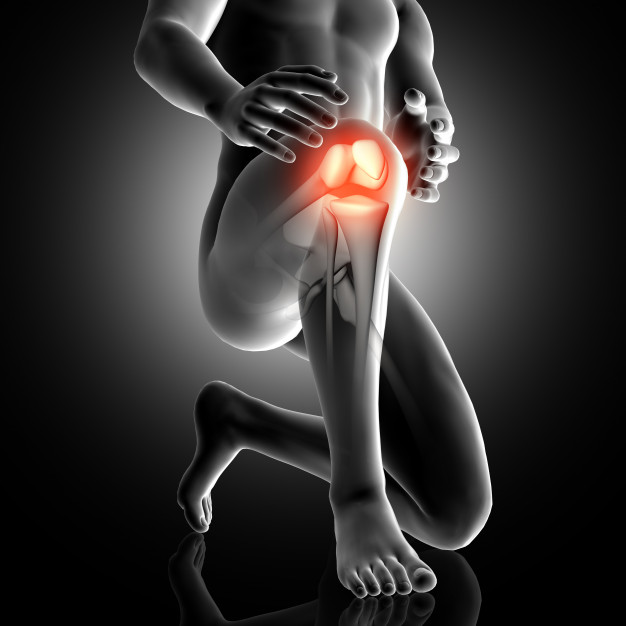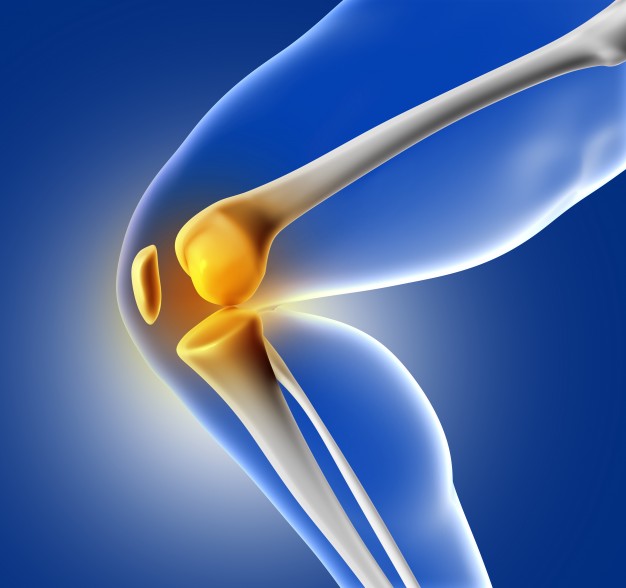General Information About The Knee
Anatomy of the Knee
The anatomy of the knee consists of bones, ligaments, cartilages and tendons.
The bones involved are the Femur (the thigh bone), the Tibia (the shinbone) and
the patella (the knee cap). The ligaments involved are collateral and cruciate ligaments.
Ligaments are another type of soft tissue. They hold the bones of the joint together.
Cartilage is a layer of smooth, soft tissue. It covers the ends of the thigh bone
and shin bone, and it lines the underside of the kneecap. Healthy cartilage absorbs
stress and allows the knee to glide easily without pain. Tendons attach the muscles
to the bones.
The knee joint allows us to move indifferent ways. The movements are called extension,
fiexion and rotation. A healthy knee bends easily because the joint absorbs stress
and glides smoothly. This allows you to walk, squat and turn without pain. But when
the knee is damaged, the joint may lose its ability to cushion stress. You may feel
paint during movement or even when you are at rest. The knee is a hinge point formed
where the thigh bone and shin bone meet. When the knee is healthy, the joint moves
freely. This is because the joint is covered with slippery tissue and powered by
large muscles.

Diseases of Knee
Malformations : (Varus) knee Knock - Kneed (Valgus) or Bow - Legged.
Osteoarthritis.
Secondary Osteoarthritis.
Accidents - Resulting
in injury to bone or joint parts.
Symptoms
- Pain on walking, standing or on moving the joint.
- Progressive reduction in the distance you can walk without pain.
- Hardly any relief from pain even on resting & with pain killers.
- Noises from the joint while moving them.
- Difficulty in using stairs, toilet
and getting up from floor or chair.
- Sensation of locking of the knee joint.
- Deformity of the knee joint.
-
Pain at night / rest or pain requiring regular pain killers Over time, wear and
tear occurs due to poor alignment between Femur and Tibia on the medial side (Inside)
or on the lateral side (Outside).
Stages of Destruction
When one or more parts of the knee are damaged, joint movement suffers. Over time,
cartilage starts to crack or wear away. Because cartilage cannot full repair itself,
the damage may continue to increase. At first, your knee may just be a little stiff.
But as the bones of the joint begin rubbing together, you're likely to feel pain.
Years of normal use can cause cartilage to crack and wear away. The first stage
of destruction by ar thritis involves the development of osteophytes (bone outgrowth).
And over time, even walking causes these sharp osteophytes to reode the ligament,
which can lead to complete destruction of the knee.
What's Involved in a Total Knee Replacement
- TKR?
What is Total Knee Replacement?
In principle, Total Knee Replacement or TKR is the replacement of the diseased knee
joint by an artificial implant. Many decades ago, the relatively simple structure
of the knee joint - the condyle of femur and distal tibia - had inspired surgeons
and medical technicians to create an artificial copy, and in the course of time,
follow - up examinations and improvements in operative methods and materials have
led to great progress, and the optimization of total knee prosthesis.
The knee prosthesis is designed to simulate the human anatomy to knee joint and
is comprised of a femoral component, tibial base plate, polyethylene insert and
patellar components.
The femoral component will fit in the condyle portion of femur bone; the tibial
base plate will fit on the distal tibia, polyetheylene insert will act like the
cartilages, the patella component will resemble the original patella. The femoral
component will glide smoothly over the polyethylene insert, thus allowing you to
walk, squat and turn without pain.
These components are made up, of metal, ceramic or polyethylene. All these materials
have been specially developed for medical purpose with good tissue tolerance and
allow the function to be as painless and lasting as possible.

Having your knee replaced?
Over the years your knee joint takes many stresses and strains during daily activities.
When a disease process or injury to your knee occurs, the cartilage surface of the
knee joint degenerate or wear out.
During total knee replacement surgery, the diseased and / or arthritic ends of the
bones are removed. A metal component is secured to the femur and plastic components
are attached to the tibia and patella. In this way, the smooth surfaces of the knee
joint are restored, pain-free motion is again possible and it works as a normal
knee joint.
For each implant type, there is a wide range of models manufactured in different
sizes as the anatomy of the knee varies from one individual to another. The surgeon
will prepare for the operation on your knee joint with a graphic plan compiled on
the basis of X-rays and will thus determine the model, size and position of the
implant parts.
What are artificial knee joints made up of ?
Material used for artificial joints are highly developed. They provide maximum tolerance
and long-term acceptance by the human body, which is called bio-compatibility. Material
development and fundamental know-how in metallurgy, material, research and testing.
In general, there are two different types of material employed for orthopedic purposes
Metals & Polymers (ultra high molecular weight polyelrylene).
When is Total Knee Replacement required?
- Persistent pain in the joint recurring regular pain killers, affecting activities
of daily living & compromising your quality of life.
- When other treatments like medicines, plysiotherapyetc have failed and no other
alternative treatment is likely to.
- X-ray confirming advanced arthritic changes in the joint.
Before Surgery - Getting yourself
ready
Having decided to perform the total knee replacement surgery for you, various members
of the staff will help you to prepare for the surgery as well as your recovery.
At any time, if you have any doubts or require any clarification, please feel to
call on your surgeon.
- An anaesthetist will visit your for pre-operative examination and assessment, if
it has not been done before.
- An orthopaedic team will again visit you to give a final check and be available
for any last minute questions.
- Please make sure you inform about all the medicines you are taking at the moment
for Hypertension, Diabetes etc. to the visiting Physician
The Surgery
During the operation, the diseased knee joint will be replaced by an artificial
implant. The intervention will be made through a skin section in a vertical mid-line
incision on the surface of the muscles near the knee joint. The procedure of implanting
an artificial knee joint is a routine operation. For this reason, possible complications
should not be a cause of concern; rather, they should be seen as part of careful
patient information. Total Knee Replacement surgery involves the removal of the
diseased and / or arthritic ends of the femur and tibia and few cuts to shape the
bones to fit the components. After these cuts are made, a metal component is secured
to the femur and plastic components are secured to your tibia and to the back of
your patella or knee cap. The knee is now moved through its range of movement to
see if the total knee joint is stable. With everything secure, the soft tissues
are sutured back together.
Safety Precautions
Do not soak in water until your physician approves, and your incision is completely
healed.
Continue to use your crutches or walker until your doctor tell you to stop.
Continue to wear your white surgical stockings (TED hose) until your doctor tells
you to stop.
Follow the weight bearing guidelines giving by your doctor.
Do not drive until your doctor approves.
Do not jump or twist.
Do not jerk or pull on anything.
Do not run or jog.
Notify your doctor or dentist that you have an artificial joint. This is important
for any procedure for routine dental cleaning.
Do not lift and carry anything over 15 to 20 pounds.
Remove rugs and objects that are below knee level.
Call Your Doctor If
- You have any numbness or decreased motion of your foot or leg.
- You have
excessive pain, swelling or drainage.
- The edges of your wound do not seem to be healing together.
- You have a fever
or any signs or symptoms of an infection.
Physiotherapy
Physiotherapy is an essential port of your recovery following a total knee replacement.
Physiotherapy aims to
- Keep your chest clear.
- Provide an exercise program to improve joint movement
strength and flexibility.
- Improves mobility and confidence with an appropriate walking aid.
The Physiotherapist will initially review your at the orthopaedic clinic and assess
your knee movement and strength. You will be provided with on appropriate walking
aid and exercise program. Please practice both prior to your admission as this will
assist your recovery. A list of exercises has been provided in this book.
At the clinic, the Physiotherapist will discuss your recovery and progress goals
following surgery. This goals are listed on the following page.
A "CPM" (continuous passive motion) machine may be used following surgery to improve
the flexibility of your knee. The use of this machine is dependent upon your surgeon's
requirements.
Goals Following Surgery
The Physiotherapist will visit you daily to assist you to become independent, safe
and confident with:
Your walking aid.
Bending your knee to 90º.
Negotiating stairs.
Your exercise routine.
Discharge from hospital depends upon these goals being achieved. This usually occurs
between day 2 and day 4.